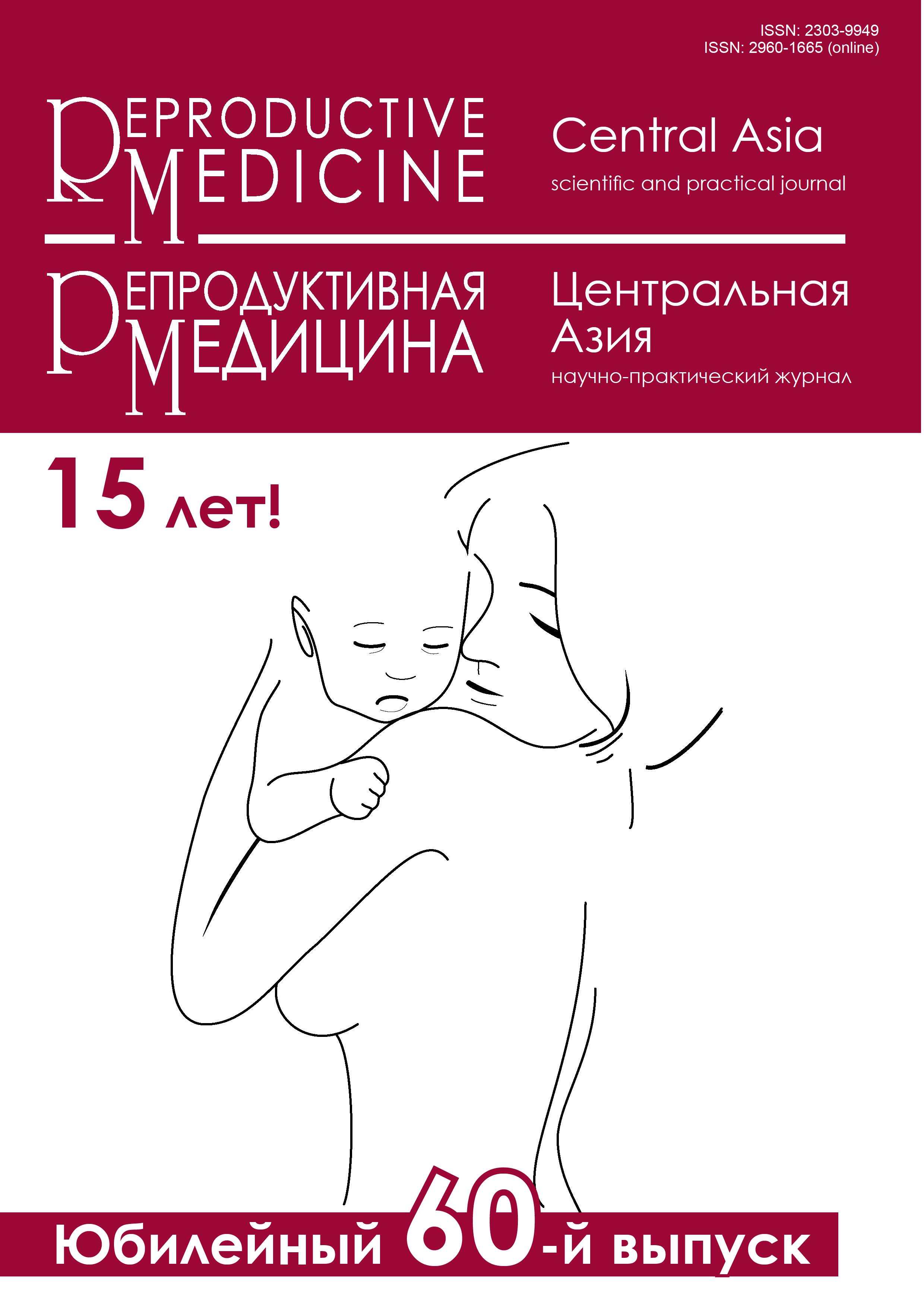An additional poor-quality embryo for transfer: an impact on ART program outcome
DOI:
https://doi.org/10.37800/RM.3.2024.65-72Keywords:
single embryo transfer (SET), double embryos transfer (DET), blastocyst, assisted reproductive technology (ART)Abstract
Relevance: Nowadays, multiple pregnancies are considered an adverse outcome associated with ART (Assisted Reproductive Technology), leading to high rates of maternal and perinatal mortality and morbidity. The number of embryos transferred should be minimized to reduce the risks of multiple pregnancies. Given the high frequency of live births after blastocyst transfer, many ART clinics are moving away from using DET (Double Embryo Transfer) in favor of SET (Single Embryo Transfer).
In clinical practice, there are cases where two blastocysts are transferred, one of good quality and one of poor quality. This approach may increase the live birth rate (LBR) at a low frequency of multiple pregnancies.
The study aimed to determine the impact of transferring a poor-quality blastocyst and slow-growing embryos alongside a good-quality blastocyst on pregnancy outcomes.
Materials and Methods: This study analyzed data from patients under 34 years old who underwent IVF-ICSI programs from January 2015 to December 2020. The outcomes of "fresh" transfers on the fifth day of development were compared among the following groups: 1 good-quality blastocyst (SET-GQ), 1 good-quality blastocyst + 1 poor-quality blastocyst (GQ+PQ), 1 good-quality blastocyst + 1 early blastocyst or morula (GQ+EBM), and 2 good-quality blastocysts (DET-GQ) – the control group.
Results: No significant difference was found in LBR when comparing the SET-GQ group with the GQ+PQ and GQ+EBM groups. The frequency of multiple pregnancies (2 or more fetuses at 6 weeks) was significantly lower in the SET-GQ group compared to the GQ+PQ and GQ+EBM groups.
Conclusion: Adding a poor-quality embryo does not increase the LBR but significantly increases the multiple pregnancies rate.
References
Maheshwari A, Hamilton M, Bhattacharya S. Should we be promoting embryo transfer at blastocyst stage? Reprod Biomed Online. 2016;32(2):142-146.
https://doi.org/10.1016/j.rbmo.2015.09.016
Glujovsky D, Quinteiro R, Alvarez Sedo C, Ciapponi A, Cornelisse S, Blake D. Cleavage-stage versus blastocyst-stage embryo transfer in assisted reproductive technology. Cochrane Database Syst Rev. 2022;19(5):CD002118.
https://doi.org/10.1002/14651858.CD002118.pub6
Полумискова А.О., Тевкин С.И., Шишиморова М.С., Джусубалиева Т.М. Переносы медленно растущих эмбрионов: «свежие» морулы/ранние бластоцисты 5-го дня или размороженные бластоцисты 6-го дня развития? Пробл Репрод. 2022;5(28):46-54.
Polumiskova AO, Tevkin SI, Shishimorova MS, Dzhusubalieva TM. Transfers of slow-growing embryos: “fresh” day 5 morulas/early blastocysts or frozen-thawed day 6 blastocysts? Probl Reprod. 2022;5(28):46–54. Russian.
https://doi.org/10.17116/repro20222805146
Локшин В, Сулейменова М, Карибаева Ш, Байкошкарова С, Ибрагимов А, Ажетова Ж, Джусубалиев Н, Яхъярова М, Мухамедьяров Д, Ахметова А, Ковалева Н, Нигматова Н, Чалова Л, Арипова Р, Имтосими Д, Лапина Е, Отарбаев М, Басарова Г, Бегайдарова А. Вспомогательные репродуктивные технологии в Казахстане (данные Национального регистра ВРТ за 2020 г.). Репрод мед (Центр Азия). 2024;1:8-16.
Lokshin В, Suleimenova М, Karibaeva Ш, Baikoshkarova С, Ibragimov А, Azhetova Ж, Dzhusubaliev Н, Yakhyarova М, Mukhamedyarov Д, Akhmetova А, Kovaleva Н, Nigmatova Н, Chalova Л, Aripova Р, Imtosimi Д, Lapina Е, Otarbaev М, Basarova Г, Begaidarova А. Assisted Reproductive Technologies in Kazakhstan (2020 National ART Registry data). Reprod Med (Central Asia). 2024;1:8-16. Russian.
https://doi.org/10.37800/RM.1.2024.8-16
Kamath MS, Mascarenhas M, Kirubakaran R, Bhattacharya S. Number of embryos for transfer following in vitro fertilization or intra-cytoplasmic sperm injection. Cochrane Database Syst Rev. 2020;8:CD003416.
https://doi.org/10.1002/14651858.CD003416.pub5
Prados N, Quiroga R, Caligara C. Elective single versus double embryo transfer: live birth outcome and patient acceptance in a prospective randomized trial. Reprod Fertil Dev. 2015;27:794-800.
https://doi.org/10.1071/RD13412
Sullivan EA, Wang YA, Hayward I, Chambers GM, Illingworth P, McBain J, et al. Single embryo transfer reduces the risk of perinatal mortality, a population study. Hum Reprod. 2012;27(12):3609-3615.
https://doi.org/10.1093/humrep/des315
Capalbo A, Rienzi L, Cimadomo D, Maggiulli R, Elliott T, Wright G, et al. Correlation between standard blastocyst morphology, euploidy and implantation: an observational study in two centers involving 956 screened blastocysts. Hum Reprod. 2014;29:1173-1181.
https://doi.org/10.1093/humrep/deu033
Brosens JJ, Salker MS, Teklenburg G, Nautiyal J, Salter S, Lucas ES, Steel JH, Christian M, Chan YW, Boomsma CM, Moore JD, Hartshorne GM, Sućurović S, Mulac-Jericevic B, Heijnen CJ, Quenby S, Koerkamp MJ, Holstege FC, Shmygol A, Macklon NS. Uterine selection of human embryos at implantation. Sci Rep. 2014;4:3894.
https://doi.org/10.1038/srep03894
Macklon NS, Brosens JJ. The human endometrium as a sensor of embryo quality. Biol Reprod. 2014;91(4):98.
https://doi.org/10.1095/biolreprod.114.122846
Tannus S, Cohen Y, Henderson S, Al Ma'mari N, Shavit T, Son WY, Dahan MH. Fresh transfer of day 5 slow-growing embryos versus deferred transfer of vitrified, fully expanded day 6 blastocysts: which is the optimal approach? Hum Reprod. 2019;34(1):44-51.
https://doi.org/10.1093/humrep/dey351
Polumiskova A, Shishimorova M, Tevkin S, Jussubaliyeva T. The best of the worst: analyze of outcome in artificial reproductive technologies (ART) fresh cycles with transfers of slow-growing embryos and expanded poor-quality blastocysts. Hum Reprod. 2022;37(1):133.
https://doi.org/10.1093/humrep/deac107.128
Gardner DK, Schoolcraft WB. Culture and transfer of human blastocysts. Curr Opin Obstet Gynecol. 1999;11(3):307-311.
https://doi.org/10.1097/00001703-199906000-00013
Practice Committee of the American Society for Reproductive Medicine and the Practice Committee of the Society for Assisted Reproductive Technologies. Guidance on the limits to the number of embryos to transfer: a committee opinion. Fertil Steril. 2021;116:651-654.
https://doi.org/10.1016/j.fertnstert.2021.06.050
ESHRE Guideline Group on the Number of Embryos to Transfer; Alteri A, Arroyo G, Baccino G, Craciunas L, De Geyter C, Ebner T, Koleva M, Kordic K, Mcheik S, Mertes H, Pavicic Baldani D, Rodriguez-Wallberg KA, Rugescu I, Santos-Ribeiro S, Tilleman K, Woodward B, Vermeulen N, Veleva Z. ESHRE guideline: number of embryos to transfer during IVF/ICSI. Hum Reprod. 2024;39(4):647-657.
https://doi.org/10.1093/humrep/deae010
Abuzeid OM, Deanna J, Abdelaziz A, Joseph SK, Abuzeid YM, Salem WH, et al. The impact of single versus double blastocyst transfer on pregnancy outcomes: a prospective, randomized control trial. Facts Views Vis Obgyn. 2017;9(4):195-206.
https://pubmed.ncbi.nlm.nih.gov/PMC6143087
Theodorou E, Jones BP, Cawood S, Heath C, Serhal P, Ben-Nagi J. Adding a low-quality blastocyst to a high-quality blastocyst for a double embryo transfer does not decrease pregnancy and live birth rate. Acta Obstet Gynecol Scand. 2021;100:1124-1131.
https://doi.org/10.1111/aogs.14088
Pandian Z, Marjoribanks J, Ozturk O, Serour G, Bhattacharya S. Number of embryos for transfer following in vitro fertilization or intra-cytoplasmic sperm injection. Cochrane Database Syst Rev. 2013;7:CD003416.
https://doi.org/10.1002/14651858.CD003416.pub4
Hill MJ, Eubanks AE, Csokmay JM, Christy AY, Samad Jahandideh S, DeCherney AH, et al. Is transferring a lower-quality embryo with a good-quality blastocyst detrimental to the likelihood of live birth? Fertil Steril. 2020;114:338-345.
https://doi.org/10.1016/j.fertnstert.2020.03.027
Richardson A, Moss B, Humphrey E, Davey T, Zujovic L, Hopkisson J, Raine-Fenning N. In women undergoing IVF/ICSI, does the addition of a poor-quality embryo have a detrimental effect on the outcome during double embryo transfer? BJOG. 2016;123(S2):69.
https://doi.org/10.1111/1471-0528.14095
Dobson SJA, Lao MT, Michael E, Varghese AC, Jayaprakasan K. Effect of transfer of a poor-quality embryo along with a top-quality embryo on the outcome during fresh and frozen in vitro fertilization cycles. Fertil Steril. 2018;110:655-660.
Downloads
Published
How to Cite
Issue
Section
License
Copyright (c) 2024 The rights to a manuscript accepted for publication are transferred to the Journal Publisher. When reprinting all or part of the material, the author must refer to the primary publication in this journal.

This work is licensed under a Creative Commons Attribution-NonCommercial-NoDerivatives 4.0 International License.
The articles published in this Journal are licensed under the CC BY-NC-ND 4.0 (Creative Commons Attribution – Non-Commercial – No Derivatives 4.0 International) license, which provides for their non-commercial use only. Under this license, users have the right to copy and distribute the material in copyright but are not permitted to modify or use it for commercial purposes. Full details on the licensing are available at https://creativecommons.org/licenses/by-nc-nd/4.0/.




